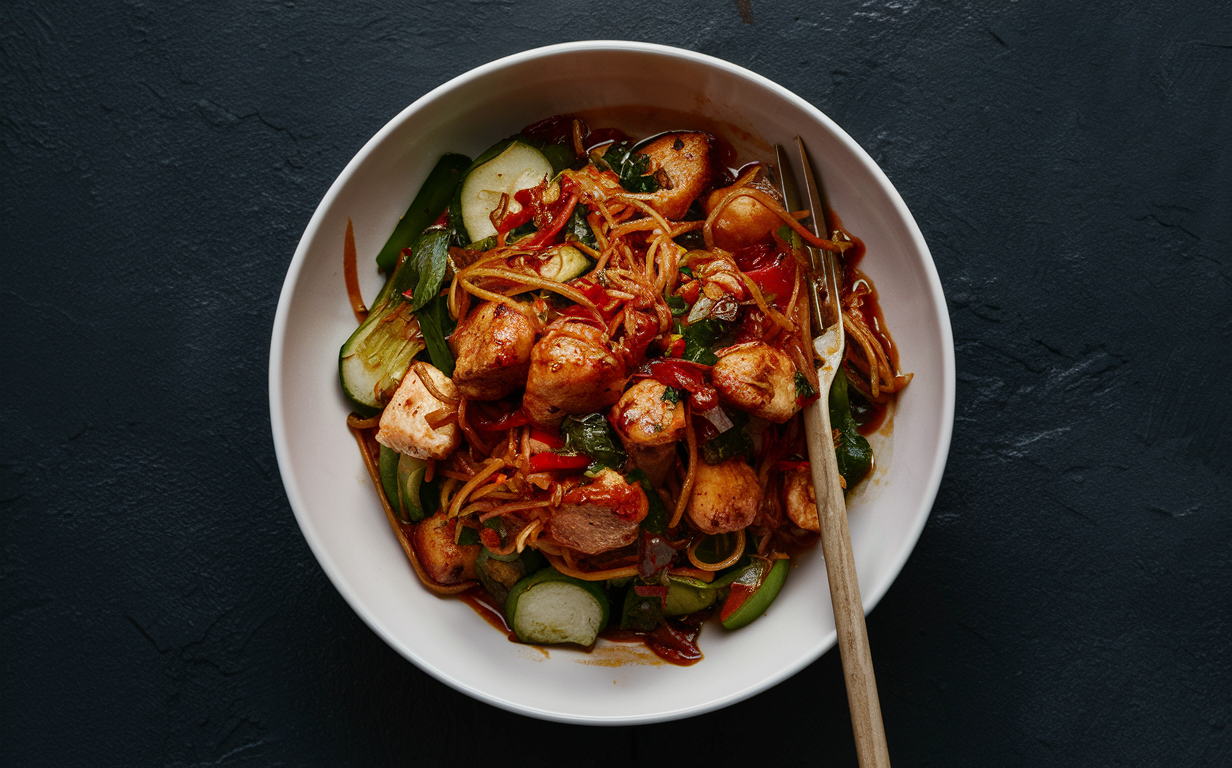I’m constantly thinking of new Gochujang recipes, and I’m constantly experimenting with it.
Gochujang is a thick, spicy-sweet Korean chili paste that imparts this really cool, rich, fermented depth to a dish.
I find, whenever I cook, I just reach for it. I’ll do a Korean Beef Bulgogi (beef thinly sliced, marinated in Gochujang, soy, sesame, garlic and a little honey, then grilled, so you get this nice, smoky char on the outside, and then the middle is this sweet and salty inside).
I’ll do a Gochujang tofu stir-fry – just toss some cubed tofu that has been lightly fried or pan-fried until it’s crispy – and put it in a Gochujang, veggie and lime-juice stir-fry. It’s a zingy, tasty dish, and the gochujang coats the tofu in this glossy glaze.
Because this dish is so quick and easy, it’s one of my go-to’s.
I feel good about putting it on the table, and it’s just totally satisfying.
Like Gochujang chicken wings tossed in a Gochujang, soy sauce, garlic and ginger sauce, and pan-baked, so now you’ve got this finger-lickin’-good wing with this spicy, sweet and salty glaze – people at my party will eat that up.
Gochujang allows me to make good food, but it adds a dynamic dimension to whatever I’m eating.
The 13 Best Gochujang Recipes and recipes
1. Gochujang Chicken Stir-Fry
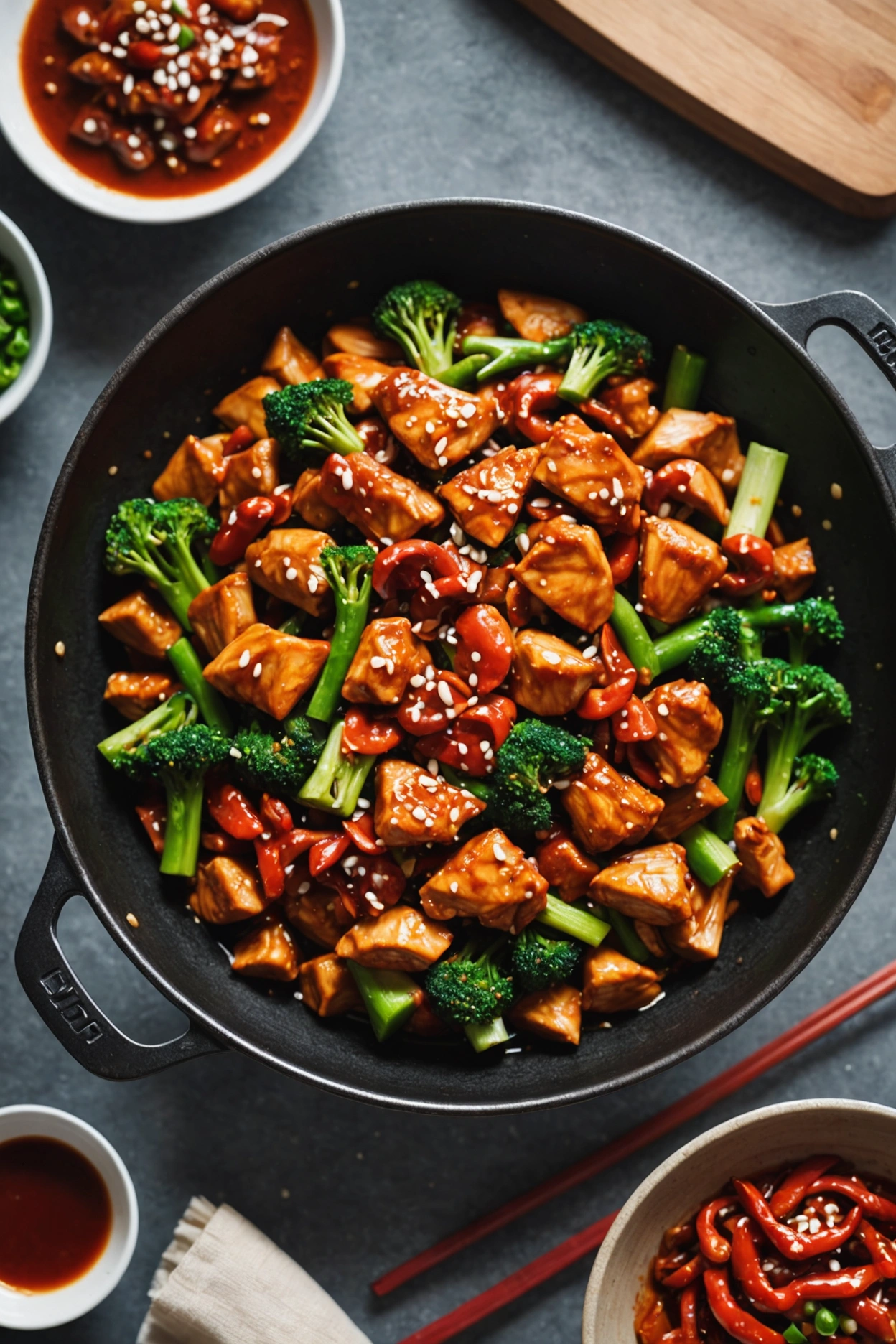
And if you want vibrant, luscious, flavor-bursting food, then reach for the bold ingredients.
My favorite is this chicken, gochujang and garlic stir-fry which relies on the sweet, spicy and savory kick of gochujang (Korean chili paste) and a splash of soy sauce turned luscious and slightly sweet through a little added sugar.
It’s how, with very few ingredients and minimal effort, you can propel an ordinary meal into the extraordinary. Here, that gorgeous, sweet, salty sauce clings to each slippery, succulent mouthful.
Sure, here’s a recipe for Gochujang Chicken Stir-Fry:

Ingredients
1 lb (450g) chicken breast, thinly sliced
2 tbsp gochujang (Korean red chili paste)
2 tbsp soy sauce
1 tbsp honey or sugar
1 bell pepper, sliced
2 cloves garlic, minced
Instructions
Marinate the chicken: Mix the chicken slices, gochujang (and water), soy sauce, honey (or sugar), and garlic in a large bowl. Let sit at least 15 minutes.
Heat the pan: Put a tablespoon of oil into a large skillet or wok over medium-high heat. Stir-fry the chicken: Transfer the chicken into the hot skillet along with the marinade from the bowl.
Stir-fry until the chicken is cooked through and coated nicely with the sauce, about 5-7 minutes.
Add vegetables: Add the sliced bell pepper to the skillet and stir-fry another 2-3 minutes until cooked, but still slightly crisp.
Combine and finish: Ensure everything is well-mixed and heated through. Adjust seasoning if necessary.
To serve: Hot, garnished with green onions or sesame seeds, with steamed rice or noodles on the side. Enjoy your Gochujang Chicken Stir-Fry!
2. Spicy Gochujang Tofu
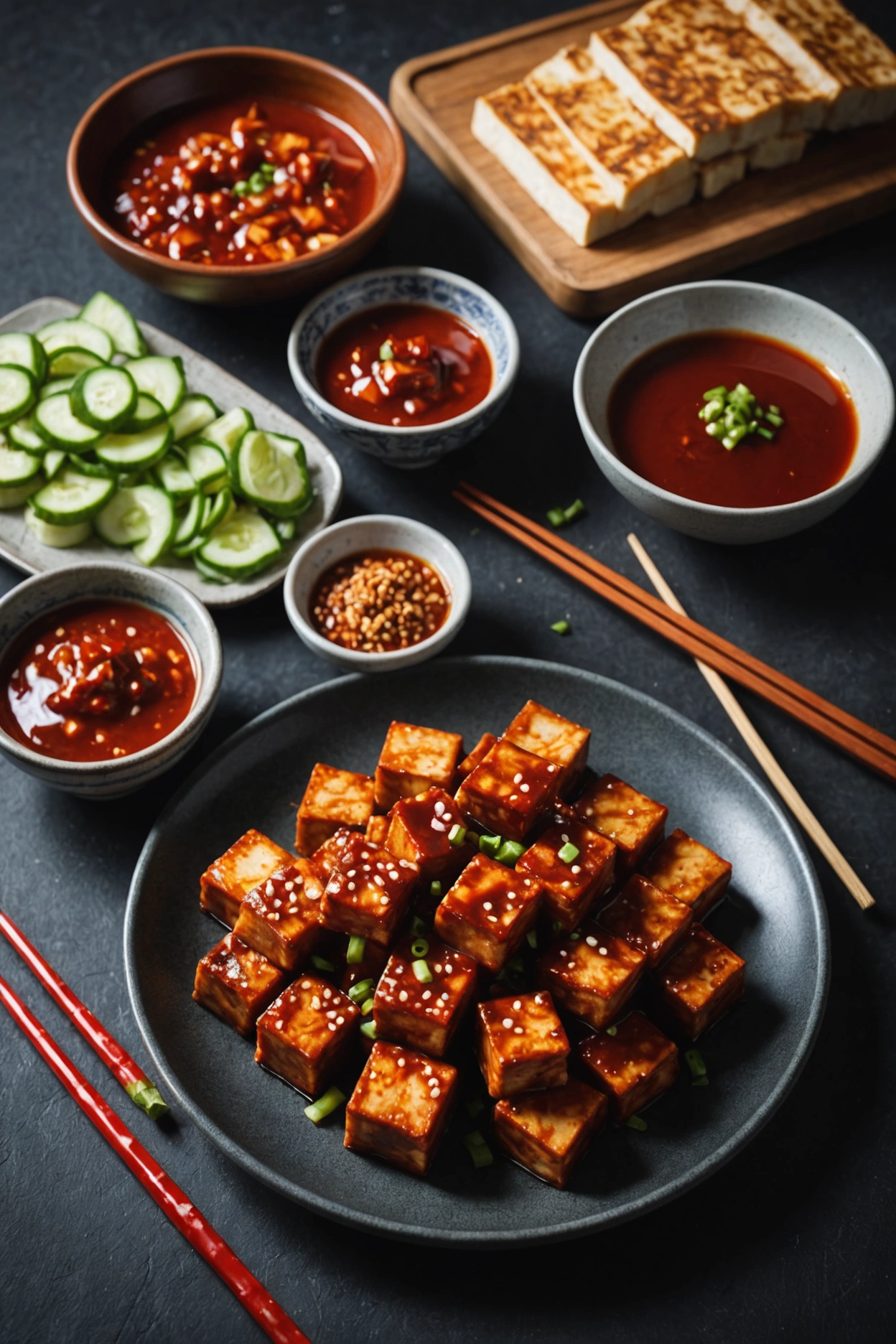
I’m constantly on the lookout for something hot and spicy to experience, and there’s nothing quite like that to make a dish pop like a bit of spicy Gochujang tofu.
The rich smokiness and heat of this Korean-inspired dish is a treat for the tastebuds and is tempered beautifully by the underlying sweet umami of the Gochujang – a fermented chili paste.
This is another recipe I’ve dabbled with, and have found that it is extraordinarily effective in transforming bland tofu into something delicious and to savory. I reckon people who like a spicy, savory, slightly sweet taste on the palate will love finding a recipe like this.
Spicy Gochujang Tofu Recipe

Ingredients
1 block firm tofu, drained and cubed
2 tablespoons gochujang (Korean red chili paste)
1 tablespoon soy sauce
1 tablespoon sesame oil
1 tablespoon maple syrup or honey
2 cloves garlic, minced
Instructions
Press tofu to remove excess water and cut it into 1-inch cubes.
Combine gochujang, soy sauce, sesame oil, maple syrup (or honey) and minced garlic in a bowl to make the sauce.
Toss tofu cubes gently in the sauce until evenly coated.
Heat a non-stick pan over medium heat and add a little oil.
Cook tofu for 5-7 minutes on each side until crispy and golden brown.
Serve hot, garnished with sesame seeds and chopped green onions if desired.
Enjoy your Spicy Gochujang Tofu!
3. Gochujang Beef Bulgogi
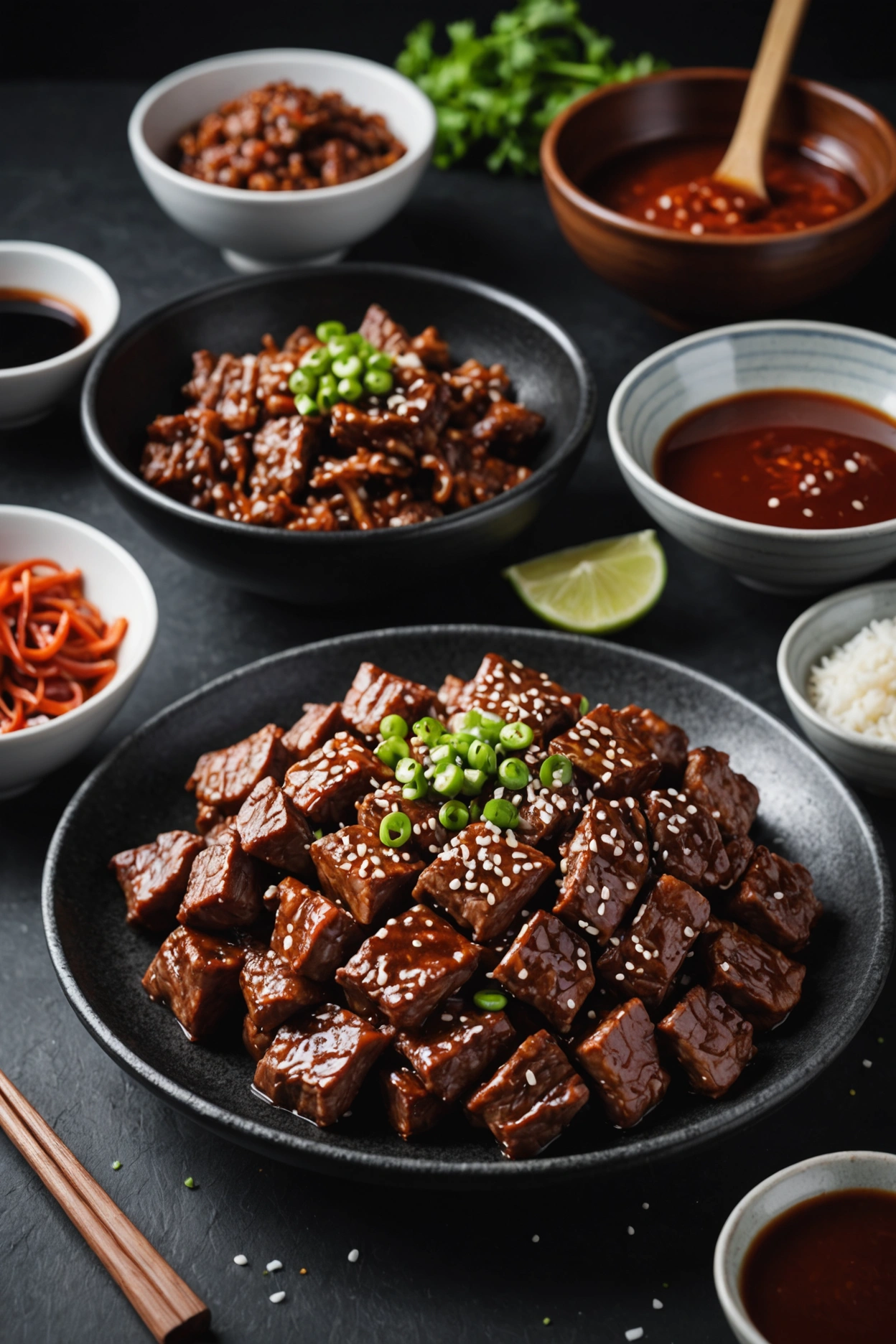
I am a foodie by hobby and by heart, and love intensely flavourful, spicy food. If I had to choose some kind of dessert to describe the experience of eating this dish, that dessert would have to be chocolate.
Not just any chocolate, mind you, but super dark chocolate – almost bitter, dense, and definitely spicy sweet. I love the savoury, spicy sweetness of the gochujang on the beef.
This is one of the most intense flavour combinations I have ever encountered. I love the way the marinade permeates the meat, making it not only incredibly flavourful but also very spicy.
This is my kind of dish. I love it when food hits the spot and fulfills every need.

Ingredients
1 lb thinly sliced beef (sirloin or ribeye)
3 tbsp gochujang (Korean red chili paste)
2 tbsp soy sauce
1 tbsp sesame oil
1 tbsp sugar or honey
2 cloves garlic, minced
Instructions
– Mix half the gochujang, the soy sauce, sesame oil, sugar or honey and the minced garlic in a bowl. – Cut the salmon diagonally into 1 in / 3 cm slices and place in a single layer in a baking dish.
– Drizzle the rest of the glaze over the top. – Marinate in the fridge for at least an hour, turning once or twice.
This will serve two people. – Wipe the grate of your broiler clean and preheat.
– Arrange the salmon slices in a single layer on the broiler. – Broil until the salmon is firm and just starting to char at the edges, about five minutes.
– Minced garlic, chopped green chillies, chopped ginger and coriander, and a teaspoon of white vinegar and soya sauce. Add the thinly sliced beef and marinate for at least 30 minutes.
Preheat a large skillet or grill over medium-high heat.
Add the marinated beef to a heavy skillet in one layer and cook for 2-3 minutes on each side, until browned and cooked through.
Stir occasionally to prevent sticking and ensure even cooking.
Serve hot garnished with white sesame seeds and sliced green onions, if desired, over bowls of steamed rice.
4. Gochujang Glazed Salmon
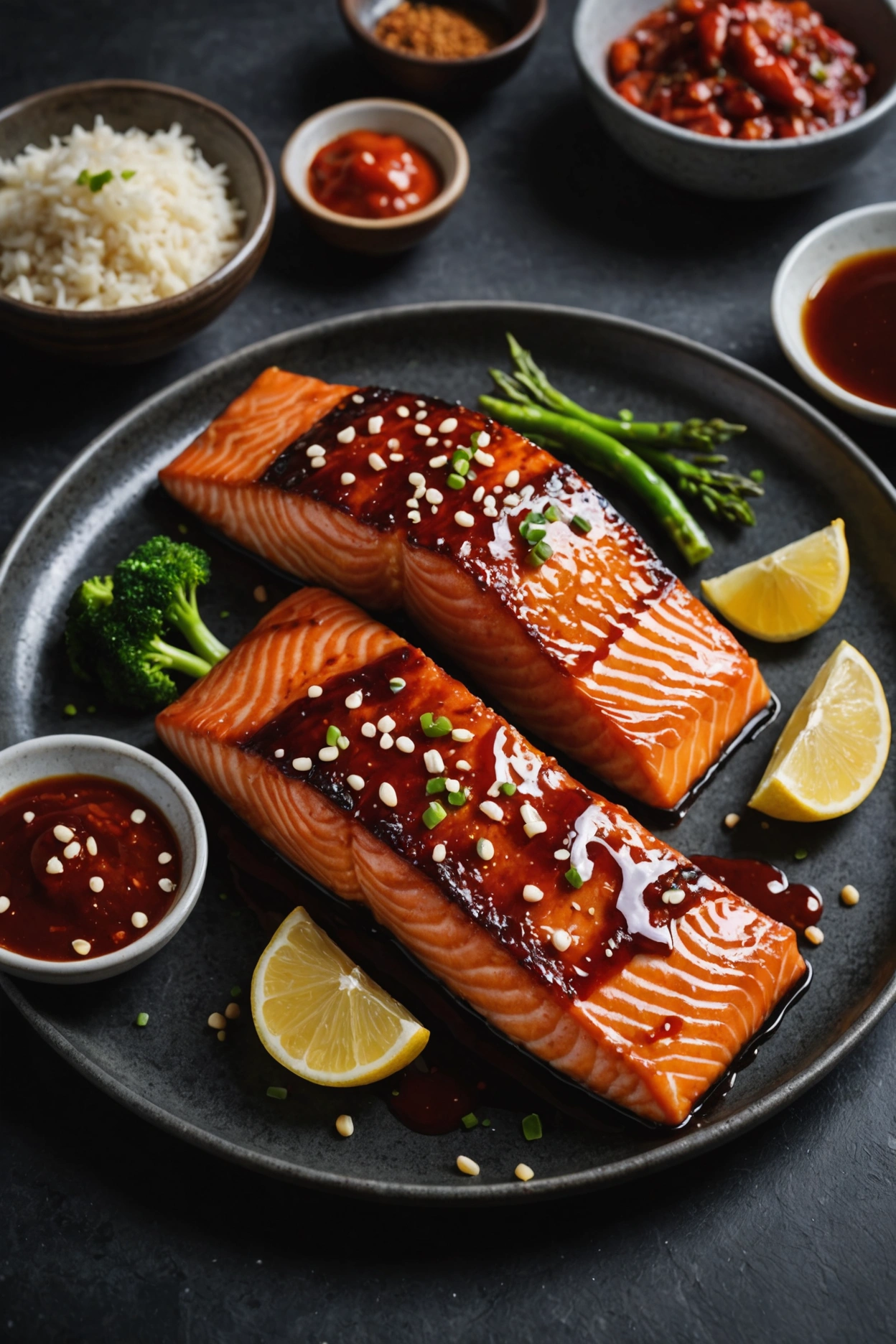
This is a variation on my favorite salmon recipe – and the marriage of the spicy, slightly sweet gochujang glaze with the rich fish is something I haven’t tired of yet.
This is now the fish I buy for weeknight meals that impress, or when I’m cooking for friends.
The addition of garlic, honey, and a splash of soy sauce reinforces the flavors, so I always have these ingredients on hand when I am cooking this recipe.

Ingredients
4 salmon fillets
2 tablespoons gochujang (Korean red chili paste)
2 tablespoons soy sauce
2 tablespoons honey
1 tablespoon sesame oil
2 cloves garlic, minced
Instructions
Preheat the oven to 400°F (200°C) and line a baking sheet with parchment paper.
Whisk together gochujang, soy sauce, honey, sesame oil and minced garlic in a small bowl.
8) Use kitchen shears to cut through the skin all the way down the back of each chicken half. 9) Brush the chicken halves with the gochujang glaze.
Let them marinate for at least an hour and up to 24 hours.
Arrange the salmon fillets on the prepared baking sheet and brush each fillet with the glaze.
Put the salmon in the preheated oven and bake for 12-15 minutes (until the fish flakes easily when pierced with a fork).
For added caramelization, broil the salmon for the last 2-3 minutes of baking.
Serve hot, optionally garnished with sesame seeds and chopped green onions.
5. Gochujang Kimchi Fried Rice
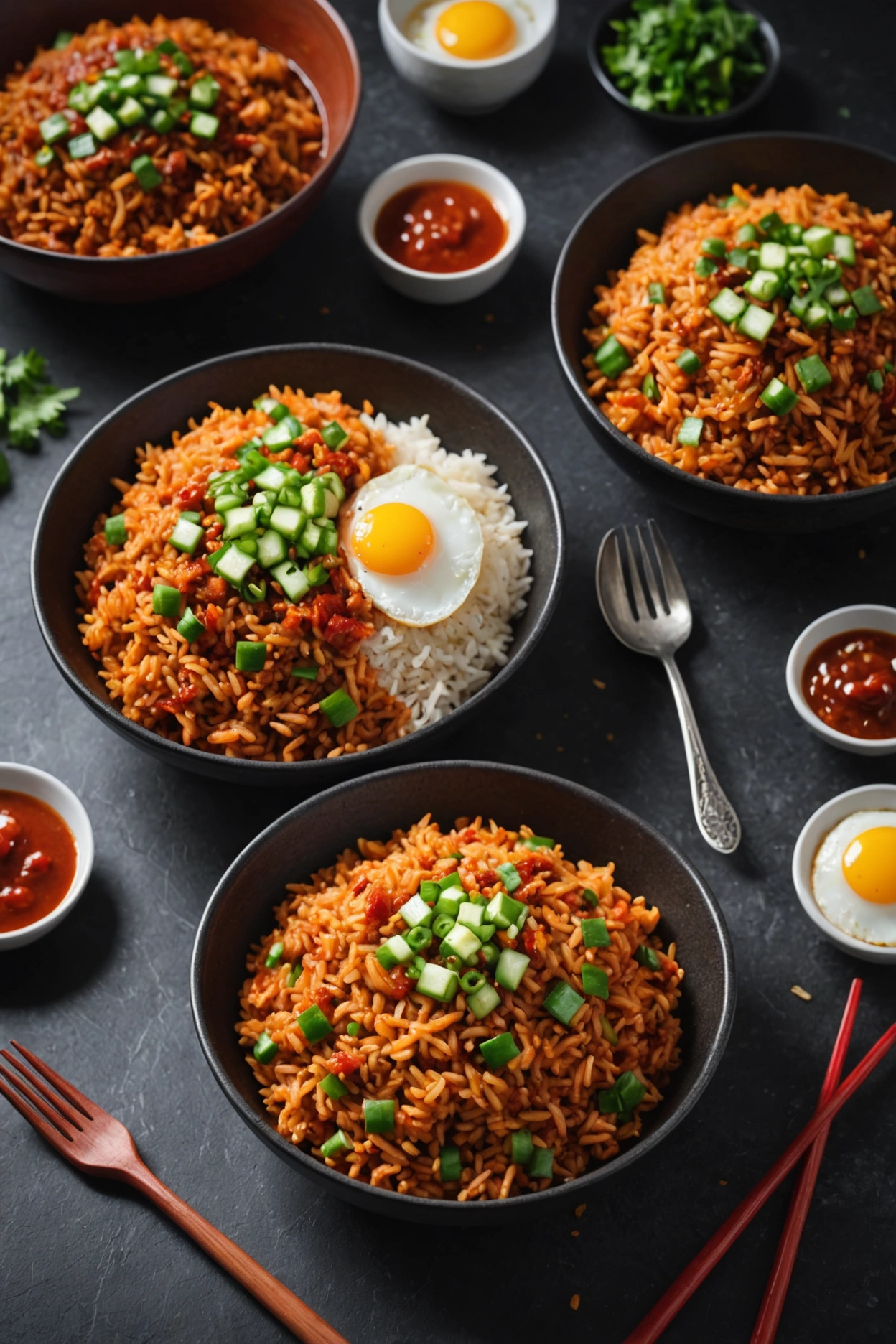
I love making it because the sweet spice, vinegar and salty flavors make a nice combination. It’s an all-in-one comfort dish for me because it’s easy to make and super delicious.
The spicey gochujang paste always adds an extra kick to the kimchi’s fermented richness, while the leftover rice soaks up all the flavour. As a side note, if you have no rice you can use noodles.
The dish evens out to a proper meal with all the vegetables and protein, which is completed with a nicely fried egg on top.
Here is a brief recipe for Gochujang Kimchi Fried Rice

Ingredients
2 cups cooked rice (preferably day-old)
1 cup kimchi, chopped
2 tbsp gochujang (Korean red chili paste)
1 tbsp soy sauce
2 green onions, sliced
2 eggs
Instructions
Heat and Sauté: Oil a large skillet and heat 1 tablespoon of oil over medium-high heat.
Add the chopped kimchi and sauté for 3-4 minutes, until fragrant.
Add Gochujang and soy sauce: Stir in the mixture of gochujang and soy sauce, cook 1-2 minutes, stirring until well mixed.
Mix with the Rice: Pour the rice into the skillet, breaking up clumps, and stir in the kimchi mixture to combine completely.
Bring to a Boil: Bring the rice and sauce to a boil, stirring occasionally.
Simmer: Simmer for 5 to 10 minutes, or until the sauce is slightly thickened, stirring occasionally.
Add the Vegetables: Add the vegetables and sausage to the rice and sauce mixture.
Add the Shrimp: Add the shrimp and stir well to combine all ingredients.
Heat Thoroughly: Continue to cook for about 5 minutes, stirring occasionally, until the rice is heated through.
Fry Eggs: Meanwhile, fry the eggs sunny side up or to your taste.
Garnish and Serve: Top with sliced green onions, and fried egg.
Serve immediately. Enjoy your delicious Gochujang Kimchi Fried Rice!
6. Gochujang Pork Ribs
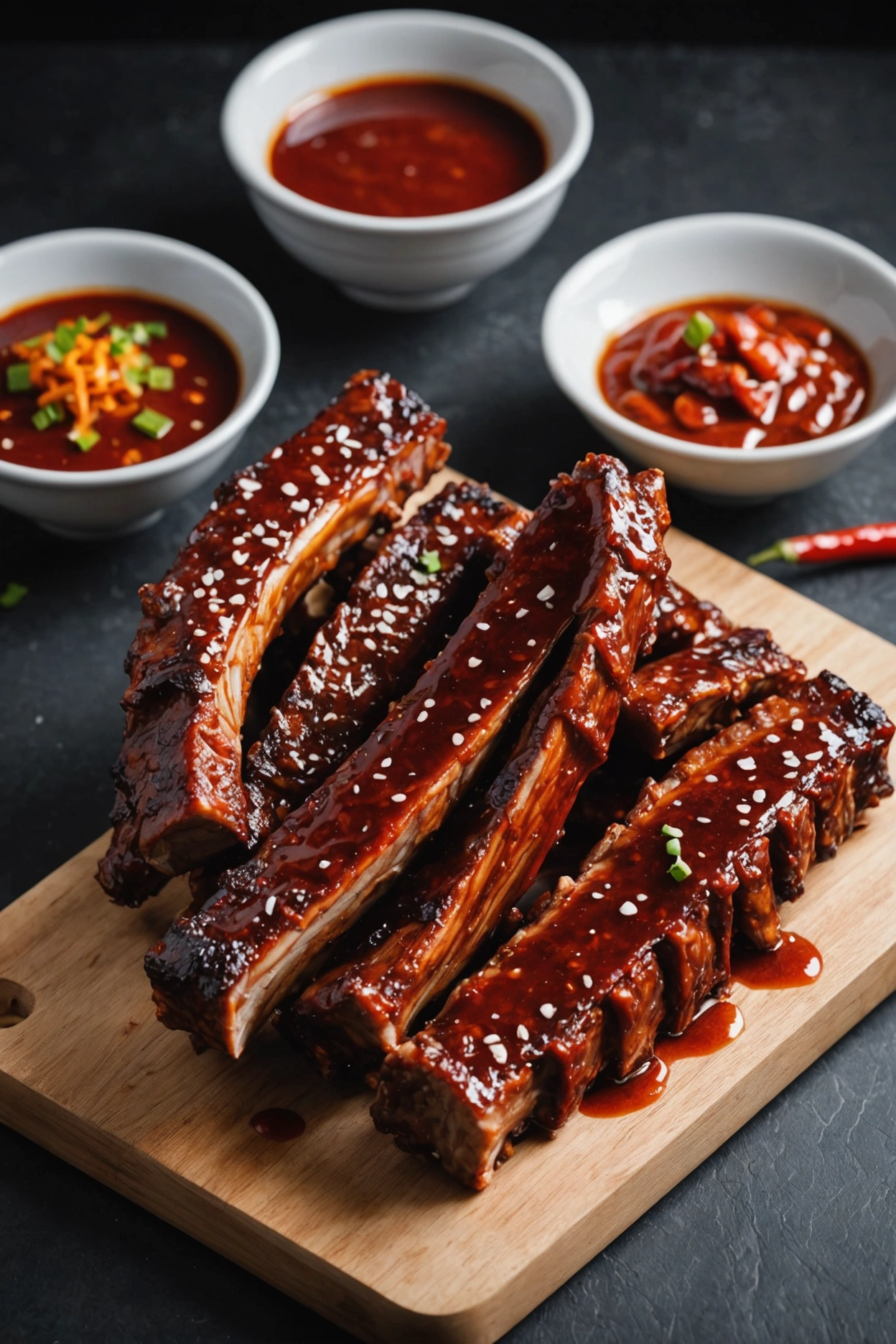
I love making interesting and tasty recipes. One of my new favorites is this spicy, delicious sticky Korean-style gochujang pork ribs with its overload of smoky sweetness and the right amount of Korean kick.
I love the way the sweet sticky pork melts in the mouth and the savoury, fermented chilli paste explodes with umami flavours. It’s the perfect fusion of the Asian cuisine to a Westerner’s palate.
This spicy pork ribs concoction always satisfies my adventurous taste buds, plus it’s super-comforting, and at the same time, it feels excitingly different whenever I eat it.
Recipe for Gochujang Pork Ribs

Ingredients
2 racks of pork ribs (about 4 lbs)
1/2 cup gochujang (Korean red chili paste)
1/4 cup soy sauce
1/4 cup honey
3 cloves garlic, minced
2 tablespoons rice vinegar
Instructions
Preheat the oven to 300°F (150°C).
In a bowl, mix gochujang, soy sauce, honey, garlic, and rice vinegar.
Rub the ribs with the mixture, ensuring they’re evenly coated.
Put the ribs in the foil-lined baking sheet with rim, cover with foil.
Bake for 2.5 to 3 hours until the ribs are tender.
4. Foil it off.
Raise the temperature to 400°F (200°C). Let it bake another 10-15 minutes to caramelise the glaze.
7. Gochujang Vegetable Bibimbap
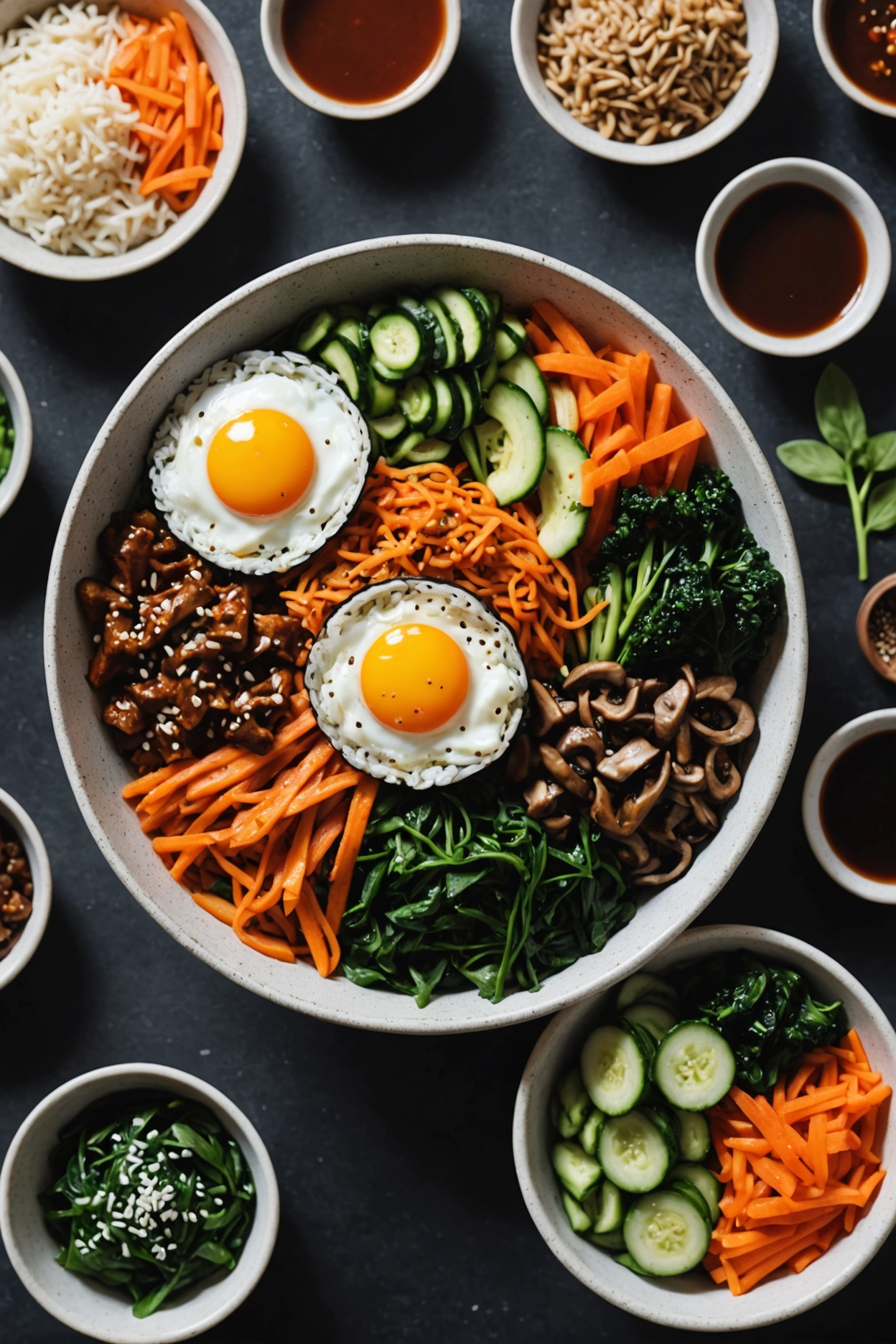
The bright green vegetables with the dark red and brown gochujang is the perfect combination of color.
I can’t describe it any other way than it just gives me joy. But all that color along with the savory richness of the gochujang and the nuttiness of the sesame give it the big, complete flavor that is what I think is so appealing.
Along with being crowd-pleasing, it’s so much fun to eat because every part of the plate is in balance: flavor, spice, texture and color. On top of sharing that with someone, it just seems like the perfect plate.
It’s what I want to make for a weeknight meal, but also when I have friends over on a weekend. It just feels as though all those elements of simplicity and comfort, sophistication and elegance, are right there in the same bite.
Gochujang Vegetable Bibimbap

Ingredients
2 cups cooked white rice
1 cup mixed vegetables (carrot, cucumber, spinach, mushrooms)
1 egg
2 tablespoons gochujang sauce
1 tablespoon sesame oil
Sesame seeds (for garnish)
Instructions
Prepare Rice: Cook 2 cups of white rice as per package instructions.
Sautee your mixed vegetables in 1 tablespoon of sesame oil, until tender, then set them aside.
Fry Egg: Fry an egg sunny-side up. Ensure the yolk remains runny.
Assemble Bowl: Place cooked rice in a large bowl. Arrange sautéed vegetables on top.
Add Sauce: Drizzle 2 tablespoons of gochujang sauce over the vegetables and rice.
Garnish and Serve: Top with fried egg and sprinkle with sesame seeds.
Mix well before eating. Enjoy your delicious and nutritious Gochujang Vegetable Bibimbap!
8. Gochujang Shrimp Skewers
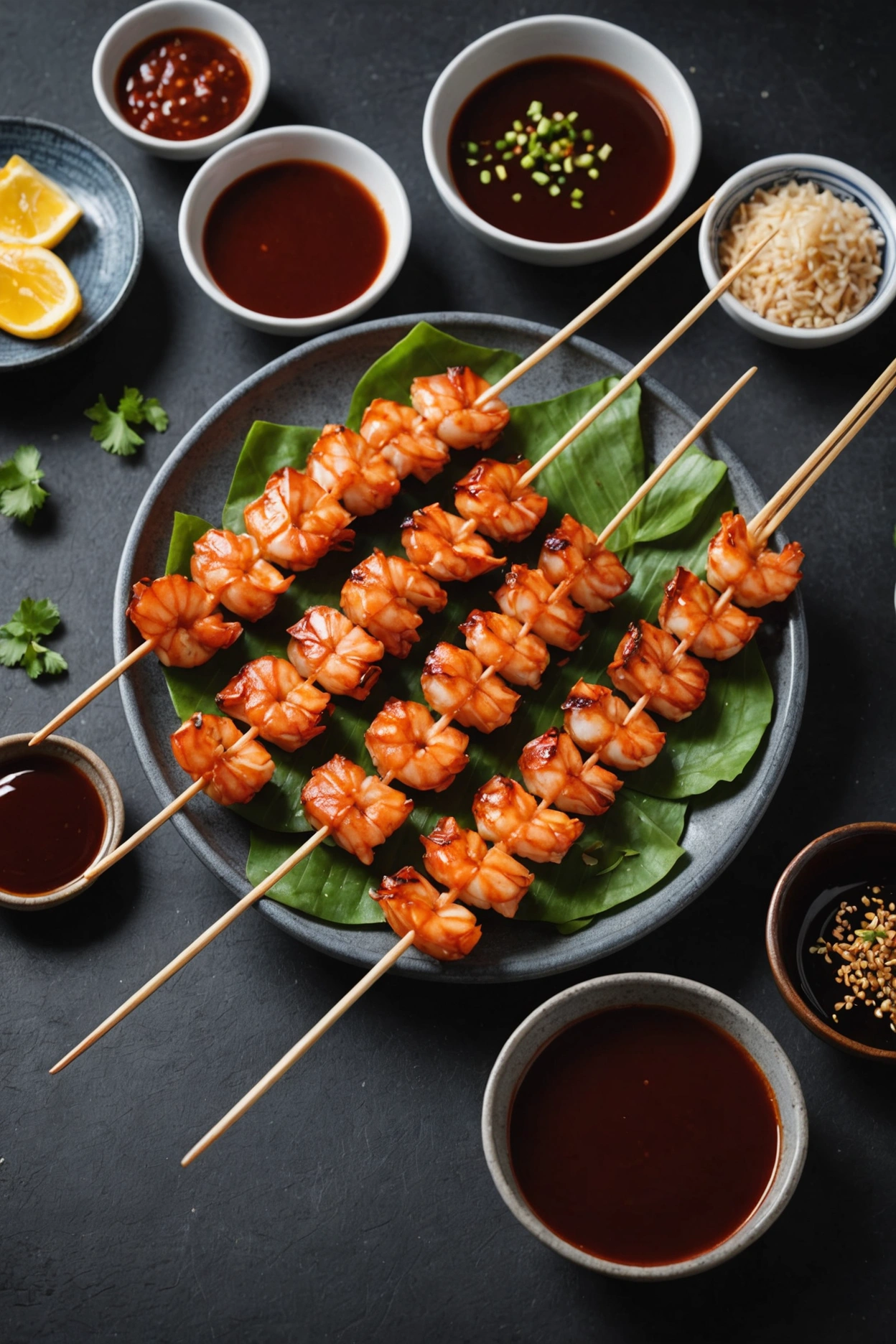
I’m an instant convert when it comes to combining the umami depth of Korean cooking with fresh seafood; and when Gochujang (that wonderful robust Korean chili paste) imparts sweet, spicy and umami flavors to shrimp, I’m out of my seat with an exclamation of hunger. There’s an alchemy here, a balanced exchange of flavors that’s hard to resist.
And the cooking of these skewers is an adventure each time. It’s so gratifying to juice up shrimp this way, to season and skewer and grill them, then feast on the tart, vibrant bites without any fuss at all.
The skewers can be a weeknight dinner. They can be a weekend.
They can be as easy or as luxurious as you want them to be.

Ingredients
1 lb large shrimp, peeled and deveined
3 tbsp gochujang (Korean red chili paste)
2 tbsp soy sauce
1 tbsp honey
2 cloves garlic, minced
1 tbsp sesame oil
Instructions
Stir together gochujang, soy sauce, honey, minced garlic and sesame oil in a bowl. Put the shrimp in the bowl and toss to coat.
Let stand for at least 15 minutes.
Preheat the grill to medium-high heat and lightly oil the grates.
Thread the marinated shrimp onto skewers.
Cook the shrimp skewers over the grill for 2-3 minutes on each side, until the shrimp is cooked through and has some slight char on it.
Serve hot, garnished with chopped green onions or sesame seeds if desired.
9. Gochujang Marinated Eggs
I enjoy cooking, and one of my recent food discoveries is marinated eggs. Korean flavors, specifically gochujang, opened up an entirely different dimension of eggs for me that I had not explored before.
It’s fun to see how many different foods these eggs go with – the hard-boiled egg is such a humble food that I seldom add it to more complicated dishes, but these eggs are a perfect addition to many meals. These eggs are also a great way to start a conversation about Korean food in general.
I enjoy serving these marinated eggs to people and seeing their surprise and pleasure.

Ingredients
6 large eggs
3 tablespoons gochujang (Korean red chili paste)
2 tablespoons soy sauce
2 tablespoons mirin (rice wine)
1 tablespoon sugar
1 cup water
Instructions
Cook the Eggs: Put the eggs in a pan of simmering water and cook for 7 minutes. Transfer them to an ice bath and cool completely before peeling.
Make the Marinade: Mix gochujang, soy sauce, mirin, sugar and water in a bowl, until the sugar is dissolved.
Sauce the Eggs : Put the peeled eggs in the dish or bowl and cover them with the marinade.
Chill: Seal it up and chill it for at least 6 hours, preferably overnight, so that the flavours can meld.
Feel for Readiness: After marinating, the eggs should have taken up the marinade and have a dark, red tint.
Serve: Halve the marinated eggs and serve over rice dishes, ramen or as is, as a snacking treat.
10. Gochujang Sweet Potato
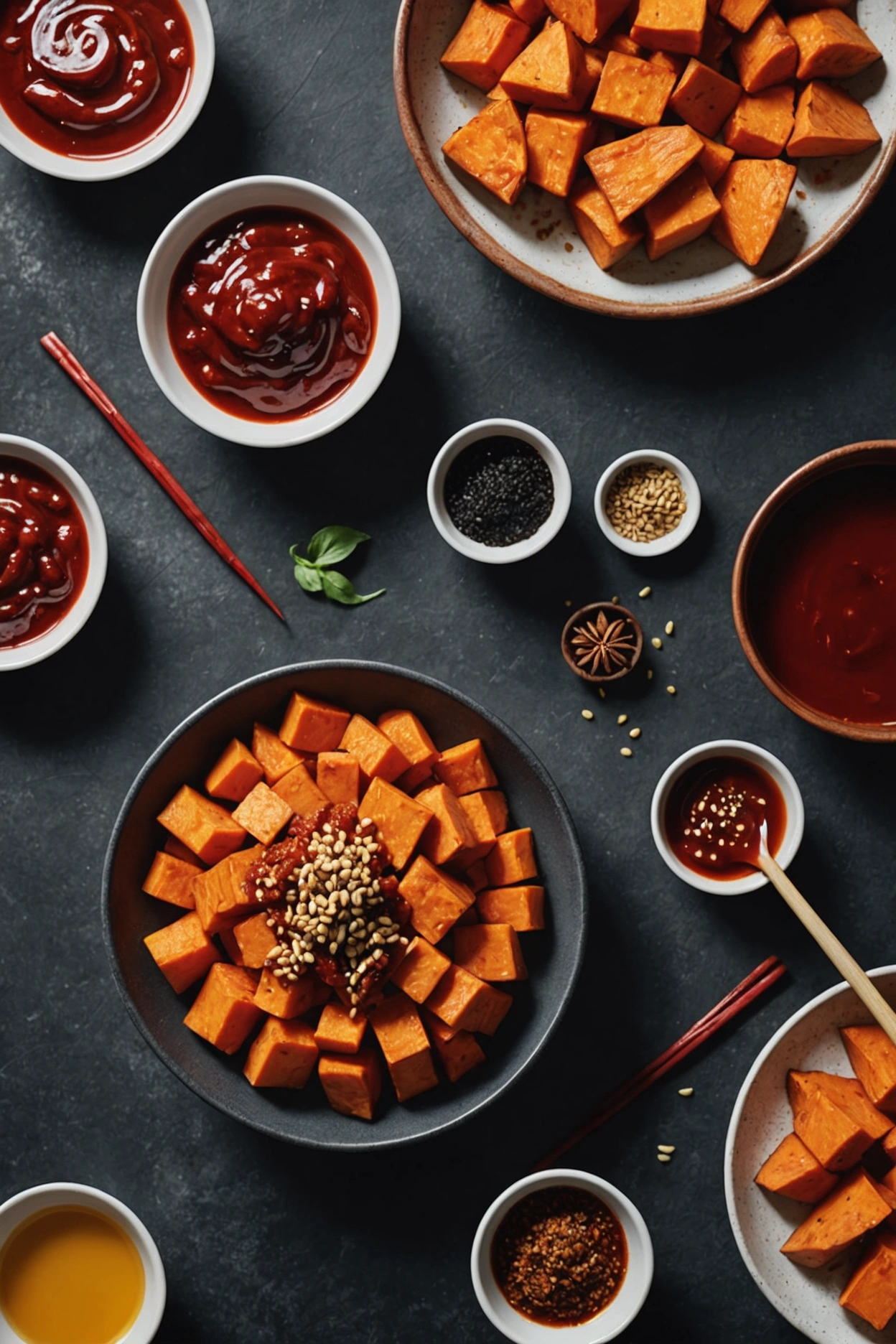
It is so good, in my opinion. I like the shape of these flavors and how they all come together.
The flavor of the sweet potato lends itself perfectly to this kind of umami, spicy, and sweet, gochujang eye-watering fine-dining type stuff. When I first had this together, I was blown away, because you have these really spicy, salty things, and then the caramelised edges of a roasted sweet potato.
It’s a great way of transforming something that is very ordinary into something that is extraordinary. It’s a great way of eating a sweet potato.
When I make it, I will eat it all by itself for dinner or I will just serve it as a side.

Ingredients
2 large sweet potatoes, peeled and cut into cubes
2 tablespoons olive oil
2 tablespoons gochujang (Korean red chili paste)
1 tablespoon soy sauce
1 tablespoon honey or maple syrup
1 teaspoon sesame seeds (optional, for garnish)
Instructions
Preheat oven to 425°F (220°C) and line a baking sheet with parchment paper.
Get it going in a large mixing bowl with equal parts olive oil, gochujang, soy sauce, and honey or maple syrup.
Add the sweet potato cubes to the bowl, tossing gently with a fork until well-coated with the sauce.
Place the cubed sweet potato, covered in the cinnamon coconut oil, in a single layer on the baking sheet.
Roast in the preheated oven for 25-30 minutes, or until the sweet potatoes are soft and golden brown, turning once.
Remove from oven and garnish with sesame seeds before serving, if desired.
11. Gochujang Noodle Soup
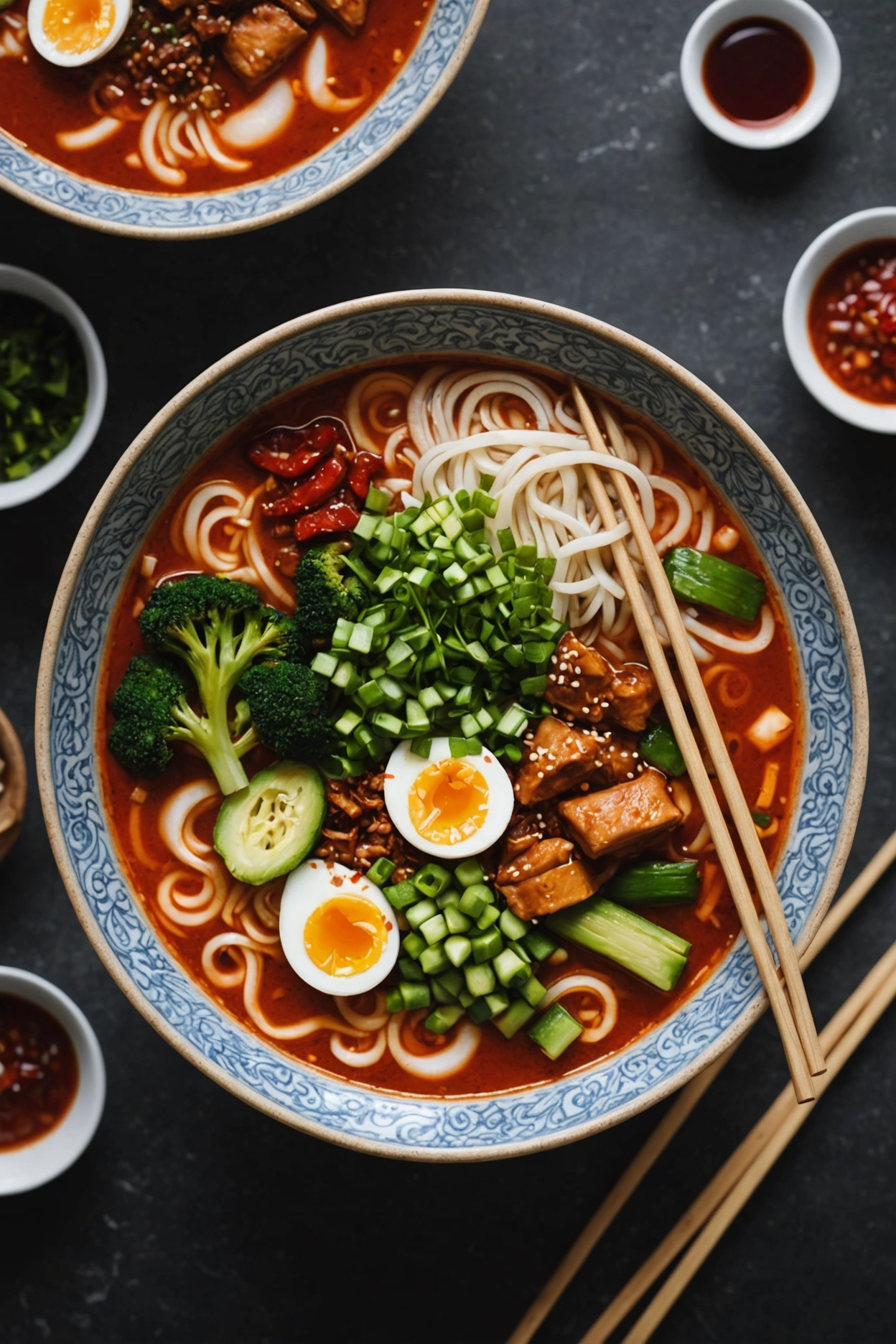
Who could resist that mellow umami depth, the heat and the balance?
Korean gochujang soup has become something of a comfort food for me, a dish of magical texture and flavor. A perfect balance of umami, heat and sweet, it combines noodles with vegetables, perhaps a protein (tofu or chicken) and a meld of bitter and sweet.
I just love those umami notes of gochujang (Korean chilli paste) with tender noodles, crisp-tender vegetables and sometimes some chicken. It goes on and on, satisfying the spirit and soul.
Ooh, I’m craving gochujang soup right now!
Sure! Here’s a concise recipe for Gochujang Noodle Soup:

Ingredients
4 cups chicken or vegetable broth
2 tablespoons gochujang (Korean chili paste)
2 cloves garlic, minced
2 cups mixed vegetables (such as mushrooms, bell peppers, and spinach)
200g noodles (such as udon, soba, or ramen)
1 tablespoon soy sauce
Instructions
Heat the broth in a large pot over medium heat.
Add the gochujang and minced garlic, stirring until fully dissolved.
Toss in the mixed vegetables and let them simmer until tender, about 5-7 minutes.
Meanwhile: cook the noodles until al dente in another pot, drain and set aside.
Add the cooked noodles to the broth, and stir in the soy sauce.
Hot, garnished ideally with green onions, sesame seeds, or soft-boiled egg if you’re feeling ‘extra’.
12. Gochujang BBQ Wings
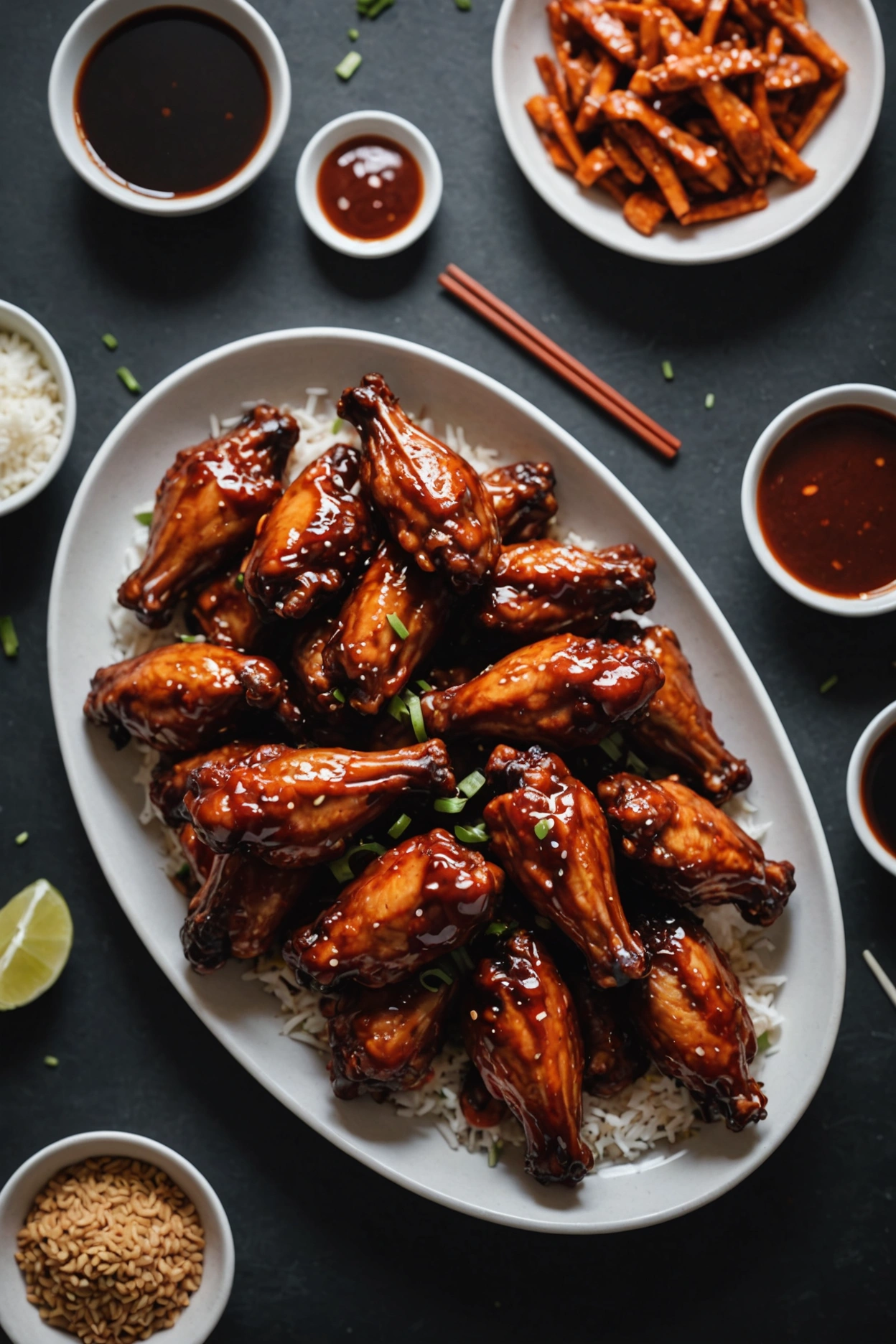
The first time I had these wings, I was taken aback by how rich and complex the flavors were. That’s the thing about gochujang – Korean red chili paste: the heat is totally unique, and the paste has a depth of umami that’s almost sweet and smoky.
I love that the marinade infuses every bite, and the leftover drippings contribute to the nuanced taste of these wings, which is a subtle mix of sweet, savoury, spicy, and smoky. Whether you’re a Korean cuisine fanatic or a barbecue enthusiast who wants to up your game, you owe it to yourself to make some of these wings for a remarkable culinary experience.
Gochujang BBQ Wings

Ingredients
2 lbs chicken wings
1/4 cup gochujang (Korean red chili paste)
2 tbsp soy sauce
2 tbsp honey
1 tbsp rice vinegar
1 tbsp sesame oil
Instructions
Heat the oven to 400°F (200°C) with a baking sheet inside. You’re trying to heat the oven and the pan at the same time to make the cookies all one even temperature.
When the oven is ready, pull it out, butter the aluminium foil or parchment, then put it all back in for a few minutes – that’s right, the aluminium foil or parchment too.
Pat the wings completely dry with paper towels, and place in a large bowl.
In a smaller bowl, whisk together gochujang, soy sauce, honey, rice vinegar, and sesame oil until well combined.
Pour the gochujang mixture over the chicken wings and toss to coat evenly.
Arrange the wings in a single layer on the prepared baking sheet.
Bake for 35-40 minutes, turning halfway through, until cooked through and crisp on the outside.

